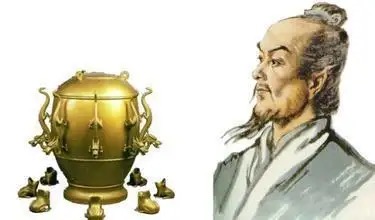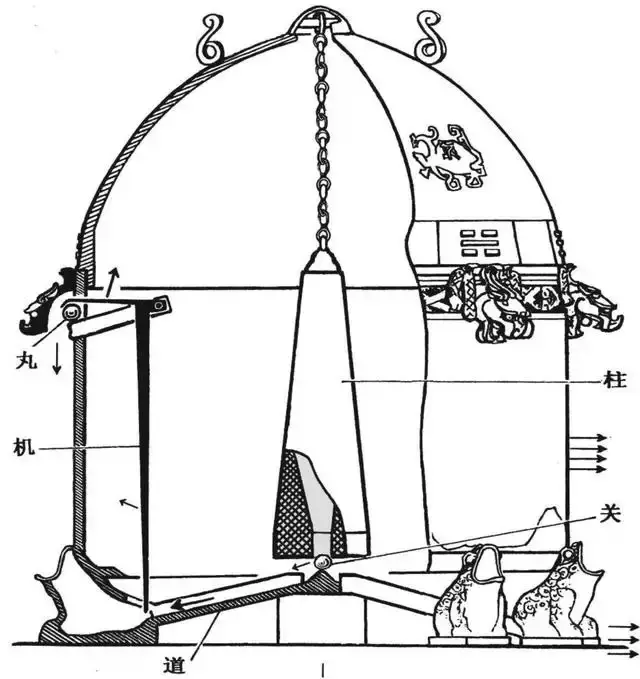The seismograph in ancient China had a nearly mystical power, thanks to mathematician and scientist Chang Heng. He was one scholar whose mathematical and scientific brilliance impressed Han Dynasty more than anything else.
For Heng, the seismometer – as it’s alternatively known – was a tool for communication from heaven. We will look at its history, functioning, and mystery.
Seismograph Han Dynasty

The Han Dynasty that ruled China from 206 BCE to 220 CE was the country’s second imperial dynasty. And the presence of a seismograph had a mystical message to the dynasty, whose tenure wasn’t smooth sailing. Warring was common, and earthquakes had more than a meaning of destruction.
Chinese in that era believed that earthquakes, with all their associated death and devastation, were a message from heaven. Therefore, it was essential to keep the dynasty informed on whether or not an earthquake was in the offing.
Who Invented the Seismograph in Ancient China?

Chang Heng is the brains behind the seismograph in ancient China. His brilliance in mathematics and physics made him a respected scholar/astronomer in Han. Heng schooled in the Chinese capitals of Luoyang and Chang’an. Besides mathematics and astronomy, he was also a seismologist, hydraulic engineer, inventor, cartographer, and a think tank – cum – politician.
He started his professional life in Nanyang as a low-level civil servant. He would then serve as Chief Astronomer and Prefect of the Majors for Official Carriages at the imperial court. In the end, he could not rise to the position of Grand Historian because of his attitude on historical and calendrical matters.
His invention kept the dynasty on tabs about an impending earthquake. While it beats logic in the 21st century to imagine that an earthquake was a message from God, the Han Dynasty believed this.
When Was the Ancient Chinese Seismograph Invented?
AD 132 is the year that the invention of the historical Chinese seismograph came to fruition. During an earthquake, a seismoscope records the shaking of the earth. Across the world, seismographs like this are buried in the ground and connected to form a network. Heng said his seismograph could detect the exact cardinal direction of a far-off earthquake with remarkable accuracy. His gadget once alerted him about an earthquake in the northwest. While his political foes could enjoy the failure of his plan because no tremors were there in the capital, a messenger arrived shortly after that to report that an earthquake had happened 248 miles northwest of Luoyang in Gansu Province.
But, Heng maintained that his seismometer takes cues from heaven. He made the Han court believe that natural disasters were a punishment for the Chinese king or one of his subordinate’s mistakes on earth.
What Was the Ancient Chinese Seismograph Made of?
History has it that Heng’s initial seismograph disappeared. However, we are fortunate that its description was well preserved. It was a vessel made of cast bronze with a domed lid, similar to a wine jar – with a hold-like usage like a wine cast.
The inner workings of the toothed machinery and inventive designs remained concealed from view. But, the vessel’s surface had fascinating plans depicting mountains, tortoises, birds, animals, and old writing. It also had a total of eight dragons, each with a ball gripped in their mouths. The dragons represented a superior power – a part of his theory about messages from heaven.
Further, around the circumference of the bottom of the vessel were engravings of eight toads. Each of them had an open mouth and an upward-facing gaze. Why he chose the engravings of these animals is a mystery besides their functionality theory.
Ancient Chinese Seismograph How it Works

There is no conclusive explanation given regarding how Chang Heng’s seismometer worked. However, most experts believe it operated on the principle of inertia— there hanging bulk on the seismometer did the detection and direction.
According to experts, the vessel would jolt at the slightest feel of an earthquake. It would result in a minute shift in the relative positions of the immovable mass and the vessel. This motion swiftly moved to the levers, which then set a ball in motion. So how would he tell what the earthquake meant?
The omen of an impending earthquake was the descent of a ball from the mouth of the dragon into the gaping maw of a toad. If you look at the position of the toad that just swallowed the ball, you could figure out which way the earthquake would hit. These characteristics made this instrument genuinely remarkable.
The objective of the design process for any instrument is to maximize the instrument’s sensitivity to the intended signal. In the same vein, it simultaneously maximizes its ability to reject unwanted signals. That’s why the pendulum in Heng’s seismograph stood at its point of resonation. By shaking only, the pendulum moves at different speeds as the earthquake’s frequency increases while the earth’s crust absorbs it. The pendulum’s length lay a few inches away from the machine’s cover to increase accuracy.
What is the Great Mystery Behind the Ancient Chinese Seismograph?
Mystery mired Heng’s seismograph in several ways. First, the dragons and toads engraving communicated in a mystical way that only the inventor (Heng) understood. The passage of the pendulum from the mouth of the dragon into the gaping maw of a toad signified an earthquake. You could determine the direction from which the earthquake will strike by observing the toad ‘swallowing the ball’ position. Scientists suspect the device’s mechanism was a vibrating pendulum. During an earthquake, the dragon’s jaws would open and drop the ball into the toad’s mouth.
Moreover, the disappearance of this machine is highly mysterious. No one ever found it after that. Luckily, documented details of how it works (ed) remain available. Although there are more advanced seismographs now, innovators indeed borrowed a lot from Heng’s innovation.
Conclusion
Chang Heng’s seismometer remains a precious machine in seismology. It is the first instrument ever explicitly constructed to detect earthquakes. It was significant because deadly earthquakes frequently hit China’s more remote regions. Therefore, a detection system assisted the emperor in determining when and where to provide timely assistance from the capital.